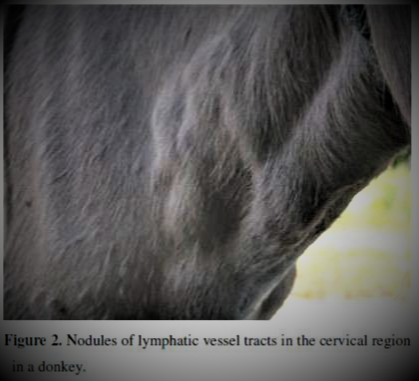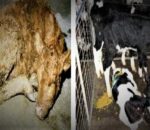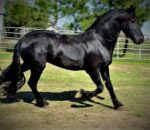Glanders is a highly contagious malady of horses, donkeys, and mules that is characterized by the presence of ulcers and nodules in the respiratory tract (air passage and lungs) and cutaneous tissues. Glander in horse can be observed in both acute and chronic forms. Depending upon the presence of the lesions, glanders can be found in various forms, including pulmonary, nasal, and cutaneous. Glanders can cause disease in camels, bears, small ruminants, jackals, dogs, cats, tigers, and lions. Cattle, pigs, rats, and fowl are totally resistant to this disease. Glanders is a zoonotic disease as this is communicable to humans.
Glanders disease is caused by Burkholderia mallei which is a gram-negative, non-spore-forming, facultative, non-motile, non-encapsulated, rod-shaped bacteria. The old names of Burkholderia malei were Pseudomonas mallei and Actinobacillus mallei. B. mallei is sensitive to commonly used disinfectants such as phenol, copper sulfate, potassium permanganate, formalin, iodine, benzalkonium chloride, and sodium hypochlorite. Humid and damp conditions favor its survival. It may stay viable for about 1 month in tap water and for 6 weeks in the contaminated stable. B. mallei is sensitive to the external environment and it is destroyed by sunlight within 24 hours through direct exposure.
Glanders was first identified by Hippocrates in the 4th century. While Aristotle named it “malleus” which means a malignant disease. This disease is common in Asia, Africa, the middle east, and South American countries. This disease has been eradicated in Europe, Australia, and North America.
How horse can get glanders?
Glanders is transmitted mainly by direct contact with the infected horses. Inhalation is the most common route of transmission of Glander in horse. The transmission also occurs indirectly through discharges of the skin and nasal secretions. Ingestion of feed and water contaminated by nasal discharge leads to the onset of the infection. Dogs, cats, and wild carnivores acquire the infection from the ingestion of infected or glanderous meat.
Pathogenesis of glanders
Burkholderia mallei enter the body of an animal through the mucous membranes of the eye, nose, gastrointestinal tract, and damaged skin. Organism after the entrance into the body reaches the bloodstream and localizes in various organs and forms nodules and ulcers in the skin. Involvement of the lungs leads to the terminal stage of broncho-pneumonia which causes death due to anoxia. While the involvement of limbs causes lymphadenitis and lymphangitis. B. mallei invades the lymph vessels and they become thick and cord-like which are known as “farcy cords”. Similarly, lymph nodes are swollen and they rupture to release dark pus, these ruptured structures are known as “farcy buds”.
Glanders Symptoms
Nasal Form
- Starts with a high fever
- Loss of appetite
- Difficult breathing due to swelling of nasal mucosa and edema of glottis
- Coughing
- Viscous mucopurulent yellow-green to grey discharge (that may stick around the nares as a crest)
- Purulent ocular discharge may also be visible
- Nodules in the pharyngeal and nasal mucosa may produce ulceration
- Enlarged and edematous regional lymph nodes (submaxillary)
Pulmonary Form
- Fever
- Difficult breathing
- Persistent dry coughing or paroxysmal coughing
- Occasionally bronchopneumonia
- Abscesses and nodules in the lungs
- Progressive debilitation or weakness
- Polyuria and diarrhea may occur
Cutaneous Form (Farcy)
It takes ample time to develop and includes the signs of
- Progressive loss of condition, weight loss, or debilitation
- Fever
- Difficult breathing
- Coughing
- Enlarged lymph nodes
- Nodules formation in the skin (mostly lower limbs and abdomen are affected)
- Nodules rupture and release oily thick yellow exudate
- Rarely swelling of joints
- Rarely Edema of legs
- Rarely glanderous Orchitis is seen
- Multifocal dermatitis may occur

Acute glanders in animals mostly shows a sudden high rise in temperature accompanied by ocular and nasal discharges. In the acute form, animals will die due to anoxia or septicemia.
Chronic glanders in horses is characterized by intermittent fever, continuing cough, and respiratory distress. Affected animals gradually lose their body condition with poor hair coats. The ulcers of the skin gradually heal up and leave an irregular star-shaped scar.
Diagnosis of Glander in Horse
Diagnosis can be based on
- Signs & Symptoms
- Isolation & identification of bacteria
- Animal inoculation test (Strauss Test)
- Serological tests
- Complement Fixation Test (CFT)
- Indirect haemagglutination test
- ELISA
- Conglutin complement absorption test
- Clinical allergic test (Mallein Test)
Differential Diagnosis
- Strangles
- Ulcerative Lymphangitis
- Epizootic Lymphangitis
- Botryomycosis
- Tuberculosis
- Sporotrichosis
- Trauma and Allergy
Treatment of Glander in Horse
As a rule, it is not recommended by veterinary authorities to treat an equine patient which is diagnosed with glanders. All infected animals should be killed because treated animals may result in a carrier state. Carrier animals are a major issue in the eradication program of the disease.
However, treatment with sodium sulfadiazine for 20 days is found to be optimal therapy. In some cases, gentamicin, and tetracycline might be effective.
Glanders Prevention and Control
Glanders prevention includes the use of the following guidelines.
- Vaccination is not available for animal use to prevent glanders.
- The carcass of a diseased animal should not be opened.
- The carcass should be either buried or incinerated.
- The premises of a diagnosed, infected animal should be vigorously disinfected.
- Fomites, including the feeding utensils, water trough, bedding material, and feed residues should be completely burnt or disinfected.
- All the contacted, suspected and imported animals must be quarantined, and properly tested and all the positive animals must be culled.
- Continuous monitoring and surveillance of herds are essential in endemic areas.
- Early detection and elimination of affected animals is very crucial to control the spread of disease.
- Veterinarians, animal handlers, and persons in contact with infected animals should follow biosafety measures.
Glanders is a contagious disease in horses, donkeys, mules, and humans. It is caused by gram-negative bacteria called Burkholderia mallei. Glander in horse is characterized by the presence of ulcers and nodules in the respiratory tract (air passage and lungs) and cutaneous tissues.
The simple answer is ‘yes’. Glanders is a highly fatal zoonotic disease. Glanders has a high mortality rate of 90 to 95% in infected humans. It is transmitted from animals to humans through inhalation, direct contact of abraded, damaged skin, and mucous membranes with infected animal tissue. Occupational exposure of veterinarians, farmers, horse traders, laboratory workers, and working personnel in stables is the main risk factor. Its symptoms in humans include
1. Low-grade fever
2. Chills
3. Headache
4. Lacrimation
5. Facial swelling
6. Pneumonia and lesions on the skin


